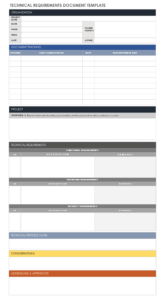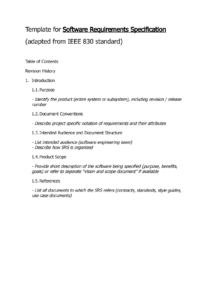A UX requirements document template is a crucial tool for ensuring that a digital product meets the needs of its users. It provides a structured framework for gathering, organizing, and communicating user requirements. By using a UX requirements document template, you can streamline the UX design process, improve communication between stakeholders, and create a product that is both functional and user-friendly.
UX requirements document templates typically include sections for:
- Project overview
- User research
- User stories
- Functional requirements
- Non-functional requirements
- Acceptance criteria
Key Elements of a UX Requirements Document Template
A UX requirements document template should be tailored to the specific needs of a project. However, there are some key elements that should be included in any UX requirements document:
- Project overview: This section provides a brief overview of the project, including its goals, objectives, and constraints.
- User research: This section summarizes the user research that has been conducted, including the methods used and the key findings.
- User stories: User stories are brief, user-centric descriptions of the functionality that the product should provide. They are written from the perspective of the user and describe how they will use the product to achieve a specific goal.
- Functional requirements: Functional requirements are detailed descriptions of the specific functionality that the product should provide. They are typically written in a structured format, such as a use case or a user story.
- Non-functional requirements: Non-functional requirements are general requirements that apply to the overall product, such as performance, security, and accessibility. They are typically written in a more general format than functional requirements.
- Acceptance criteria: Acceptance criteria are specific, measurable criteria that must be met in order for the product to be considered complete. They are typically written in a structured format, such as a checklist or a set of test cases.
Benefits of Using a UX Requirements Document Template
There are many benefits to using a UX requirements document template. These benefits include:
- Improved communication: A UX requirements document template provides a common language for stakeholders to communicate about the product’s requirements. This can help to reduce misunderstandings and ensure that everyone is on the same page.
- Increased efficiency: A UX requirements document template can help to streamline the UX design process. By providing a structured framework for gathering and organizing requirements, it can help to reduce the time and effort required to develop a product.
- Improved quality: A UX requirements document template can help to ensure that the product meets the needs of its users. By providing a clear and concise record of the requirements, it can help to prevent errors and omissions.
Conclusion
A UX requirements document template is an essential tool for any UX design project. By using a UX requirements document template, you can ensure that the product meets the needs of its users, improve communication between stakeholders, and create a product that is both functional and user-friendly.
There are many different UX requirements document templates available, so it is important to choose one that is appropriate for your project. Once you have chosen a template, be sure to tailor it to the specific needs of your project. With a little effort, you can create a UX requirements document template that will help you to create a successful product.


